第6课 凝神造像——中国传统雕塑 课件-2022-2023学年高中美术人教版(2019)美术鉴赏(45张PPT)
文档属性
| 名称 | 第6课 凝神造像——中国传统雕塑 课件-2022-2023学年高中美术人教版(2019)美术鉴赏(45张PPT) |
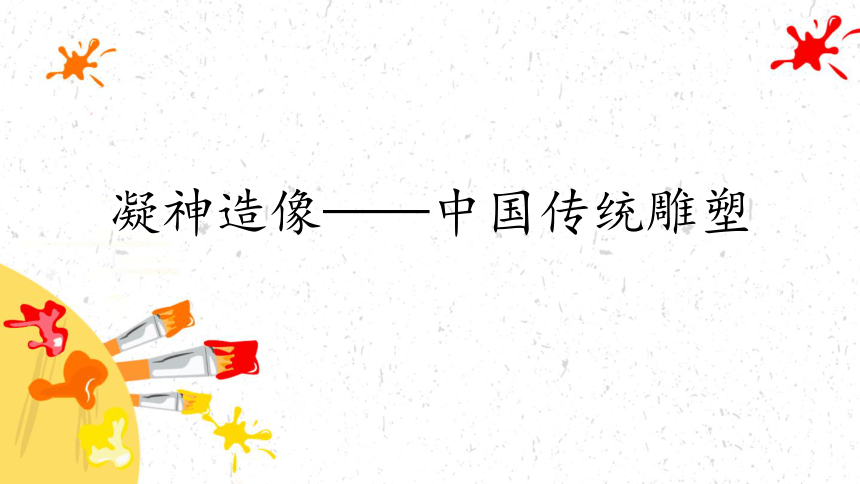
|
|
| 格式 | pptx | ||
| 文件大小 | 24.7MB | ||
| 资源类型 | 教案 | ||
| 版本资源 | 人教版(2019) | ||
| 科目 | 美术 | ||
| 更新时间 | 2022-08-12 14:41:56 | ||
图片预览

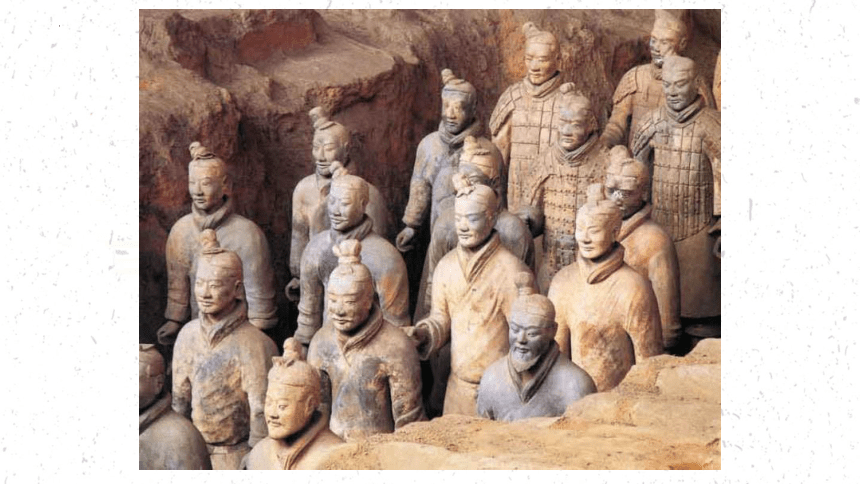

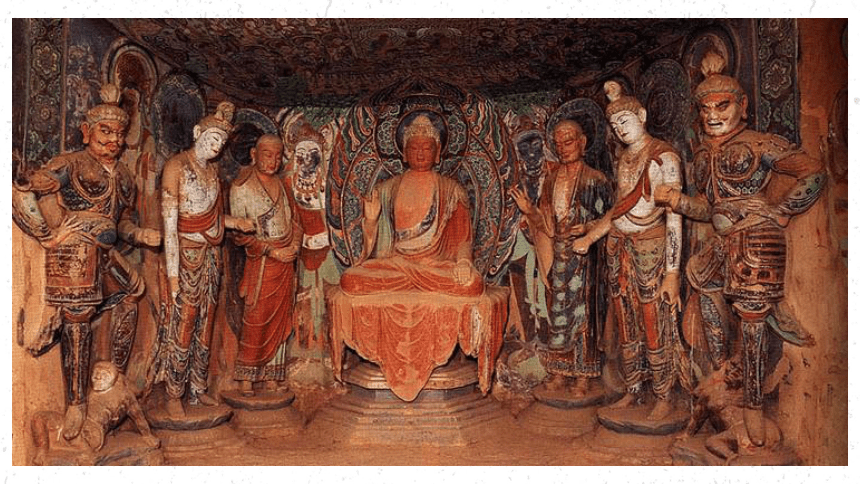
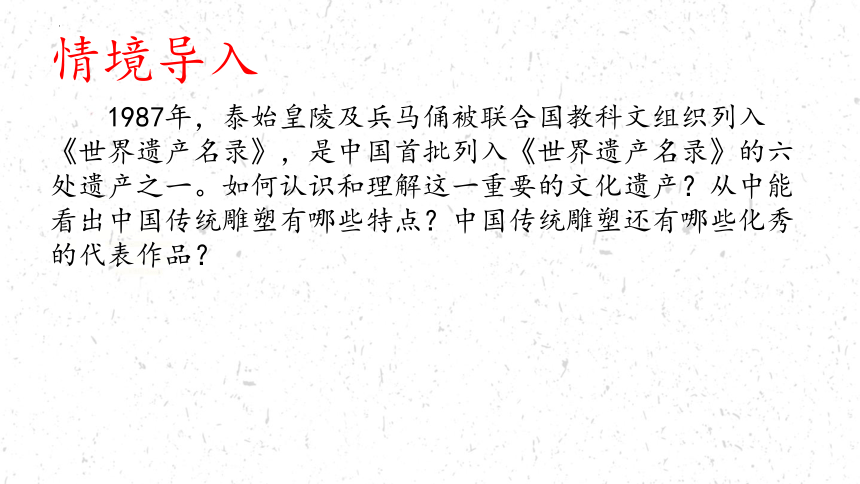
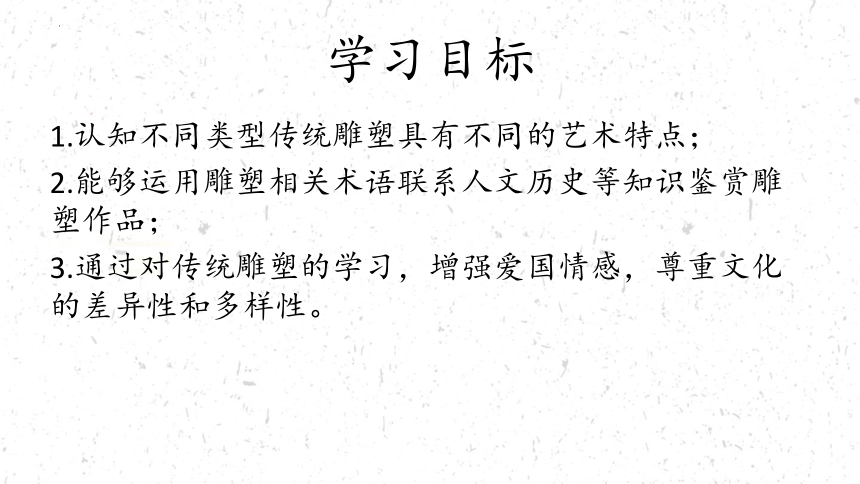
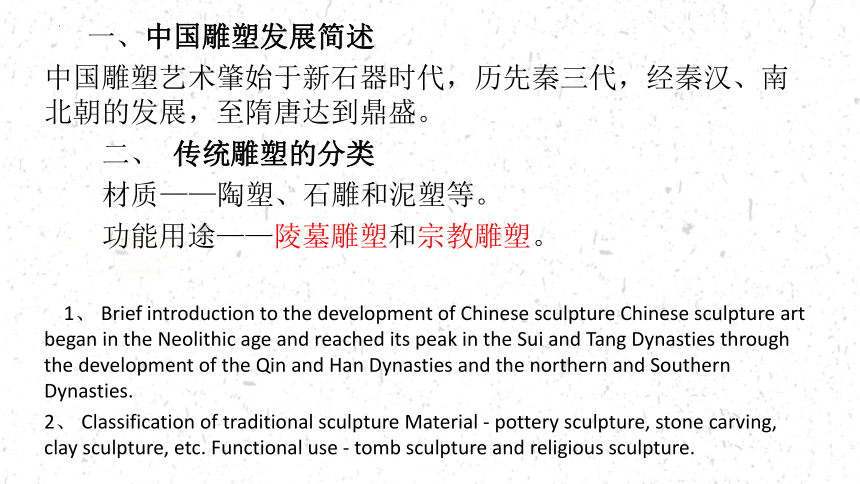
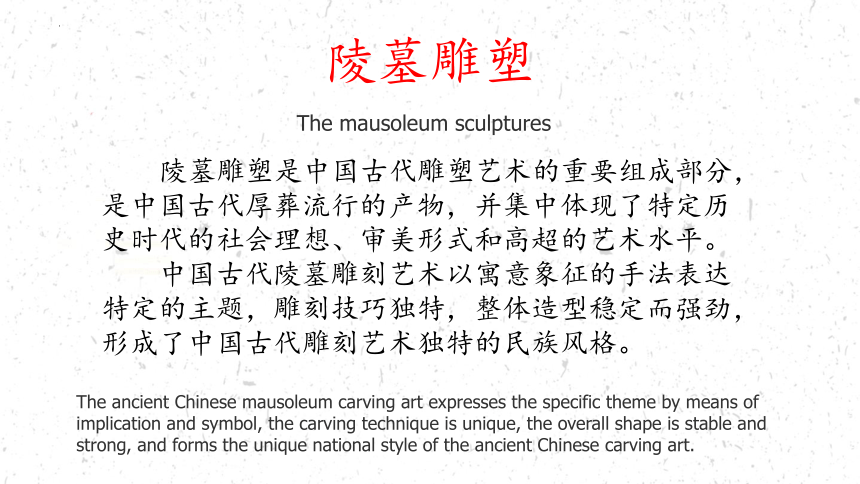
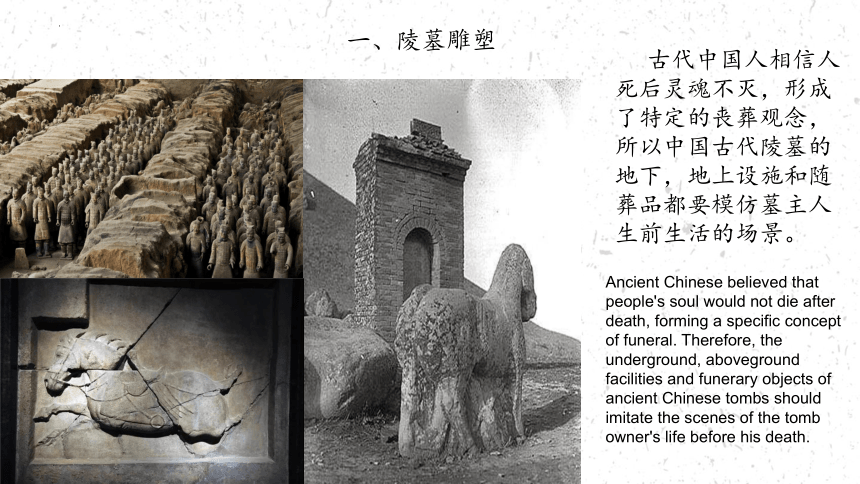
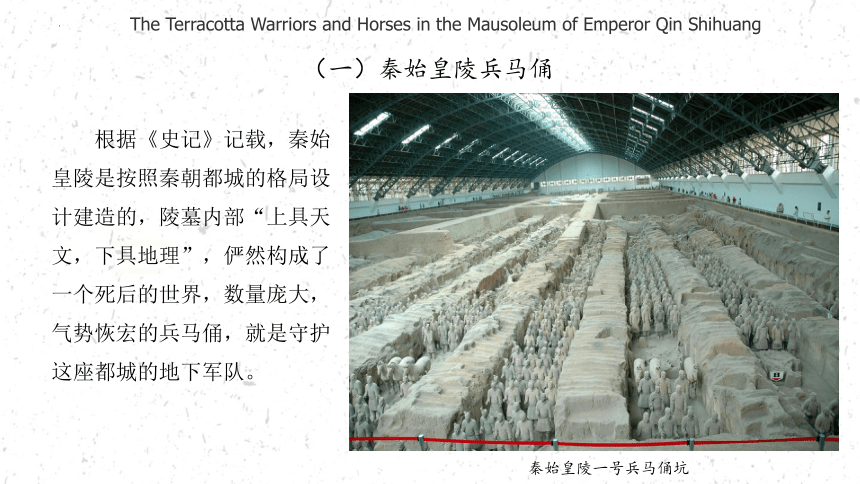
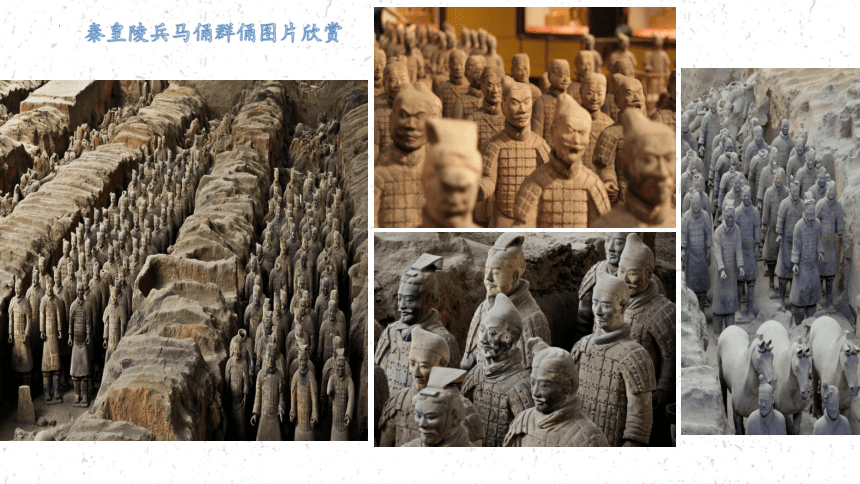
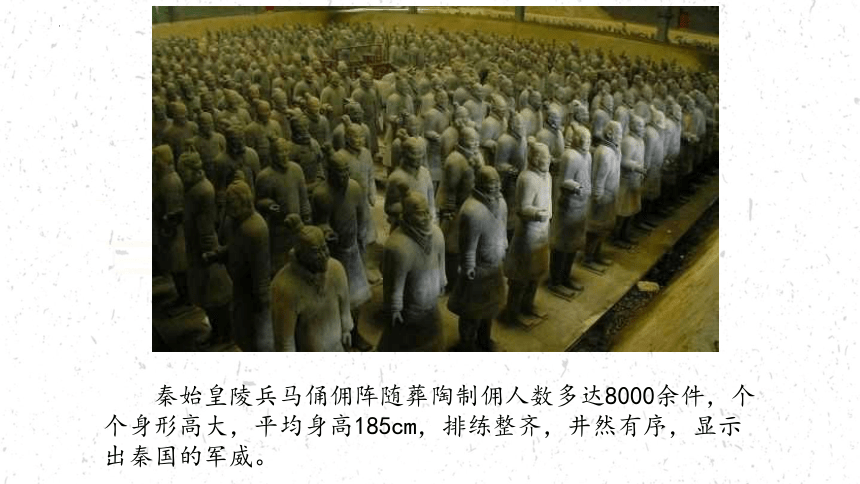
文档简介
(共45张PPT)
凝神造像——中国传统雕塑
基本问题
中国传统雕塑承载了古代中国人怎样的文化观念?
情境导入
1987年,泰始皇陵及兵马俑被联合国教科文组织列入《世界遗产名录》,是中国首批列入《世界遗产名录》的六处遗产之一。如何认识和理解这一重要的文化遗产?从中能看出中国传统雕塑有哪些特点?中国传统雕塑还有哪些化秀的代表作品?
学习目标
1.认知不同类型传统雕塑具有不同的艺术特点;
2.能够运用雕塑相关术语联系人文历史等知识鉴赏雕塑作品;
3.通过对传统雕塑的学习,增强爱国情感,尊重文化的差异性和多样性。
一、中国雕塑发展简述
中国雕塑艺术肇始于新石器时代,历先秦三代,经秦汉、南北朝的发展,至隋唐达到鼎盛。
二、 传统雕塑的分类
材质——陶塑、石雕和泥塑等。
功能用途——陵墓雕塑和宗教雕塑。
1、 Brief introduction to the development of Chinese sculpture Chinese sculpture art began in the Neolithic age and reached its peak in the Sui and Tang Dynasties through the development of the Qin and Han Dynasties and the northern and Southern Dynasties.
2、 Classification of traditional sculpture Material - pottery sculpture, stone carving, clay sculpture, etc. Functional use - tomb sculpture and religious sculpture.
陵墓雕塑
陵墓雕塑是中国古代雕塑艺术的重要组成部分,是中国古代厚葬流行的产物,并集中体现了特定历史时代的社会理想、审美形式和高超的艺术水平。
中国古代陵墓雕刻艺术以寓意象征的手法表达特定的主题,雕刻技巧独特,整体造型稳定而强劲,形成了中国古代雕刻艺术独特的民族风格。
The mausoleum sculptures
The ancient Chinese mausoleum carving art expresses the specific theme by means of implication and symbol, the carving technique is unique, the overall shape is stable and strong, and forms the unique national style of the ancient Chinese carving art.
一、陵墓雕塑
古代中国人相信人死后灵魂不灭,形成了特定的丧葬观念,所以中国古代陵墓的地下,地上设施和随葬品都要模仿墓主人生前生活的场景。
Ancient Chinese believed that people's soul would not die after death, forming a specific concept of funeral. Therefore, the underground, aboveground facilities and funerary objects of ancient Chinese tombs should imitate the scenes of the tomb owner's life before his death.
(一)秦始皇陵兵马俑
根据《史记》记载,秦始皇陵是按照秦朝都城的格局设计建造的,陵墓内部“上具天文,下具地理”,俨然构成了一个死后的世界,数量庞大,气势恢宏的兵马俑,就是守护这座都城的地下军队。
秦始皇陵一号兵马俑坑
The Terracotta Warriors and Horses in the Mausoleum of Emperor Qin Shihuang
秦皇陵兵马俑群俑图片欣赏
秦始皇陵兵马俑佣阵随葬陶制佣人数多达8000余件,个个身形高大,平均身高185cm,排练整齐,井然有序,显示出秦国的军威。
铜制车马按真实的车马1:2的比例塑造,造型精美,装饰华丽,结构和系驾逼真、完整。
这几件陶俑以不同的衣饰、动态显示了不同的身份和地位、兵种。
欣赏各种类别俑图片
有些陶俑出土时绘上鲜明的色彩,每个陶俑五官和头饰的刻画细致入微,面貌不同,年龄、神态各异,写实性极强。
这些陶俑制作时用了什么样的手法?
Some of the pottery figures were painted with bright colors when they were unearthed. The facial features and headwear of each pottery figure are described in detail, with different faces, ages and expressions, which are extremely realistic.
秦人为什么要把兵马俑陪葬坑设在距秦始皇陵封土以东约1.5公里的地方,而其他的陪葬坑却设在陵园城墙内?这种布局设计反映了什么样的观念?
霍去病墓的石雕群是汉代雕塑的精品。霍去病是西汉时期抗击匈奴的名将,其墓周围放着卧牛、伏虎、跃马等17件石雕,以纪念其赫赫战功。
(二)霍去病墓前石雕群
Stone carvings in front of Huo Qubing's tomb
汉代霍去病墓前石雕群
欣赏石雕群图片
雕刻手法——循石造型:保留天然岩石造型的基础上,通过圆雕、浮雕和刻线相结合的手法,对石头的外形略加工制作雕塑。
雕塑的特点:手法简练,造型雄健遒劲,古拙粗犷。
Carving techniques - stone modeling: on the basis of retaining the natural rock modeling, through the combination of round carving, relief and carving line techniques, the shape of the stone slightly processed to make sculpture.
The characteristics of sculpture: concise technique, vigorous and vigorous modeling, rough rough.
《立马》原是放置于霍去病墓前一座纪念碑式的雕刻,高190cm,长168cm。造型饱满坚实,昂首屹立,稳重庄严,显示出胜利者的镇定与威严。
这两件石雕特征鲜明,尤其是神态,惟妙惟肖。反映出汉代雕刻家对动物习性的高度概括和利用石材天然形状的艺术功底。
伏虎
跃马
陵墓雕塑的特点
地下:秦始皇陵 细致入微
兵马俑阵 写实性强
地上:汉代霍去病 因石象形
墓石雕群 意态生动
与陵墓雕塑不同,中国传统的宗教雕塑以宗教教义、故事、人物与题材,反映了古人虔诚的宗教信仰,其中以佛教雕塑艺术成就最高。
二、宗教雕塑
Religious sculptures
Different from tomb sculpture, Traditional Chinese religious sculpture reflects the devout religious beliefs of ancient people with religious doctrines, stories, characters and themes, among which Buddhist sculpture art has the highest achievements.
宗教雕塑
佛教在汉代沿丝绸之路传入我国,是影响我国最重要的宗教。佛教通过兴建石窟传播宗教教义,留下了技艺极其高超的艺术精品,代表着中国佛教造像艺术高峰的有甘肃敦煌石窟、山西大同云冈石窟、河南洛阳龙门石窟和天水麦积山石窟四大佛教石窟。
Buddhism was introduced into China along the Silk Road in the Han Dynasty, which was the most important religion affecting China. Buddhism spreads religious doctrines through the construction of grottoes, leaving excellent artistic works with superb skills. Four Buddhist grottoes representing the peak of Chinese Buddhist statue art are Dunhuang Grottoes in Gansu, Yungang Grottoes in Datong, Shanxi, Longmen Grottoes in Luoyang, Henan and Maijishan Grottoes in Tianshui.
(一)石窟艺术 Grotto art
佛教雕塑大量保存于石窟寺中,石窟开凿于山崖上,在中国始于十六国时期,南北朝、隋唐、宋元各代陆续开凿,遍及南北各地。其中以中国四大石窟——云冈石窟、麦积山石窟、龙门石窟、敦煌石窟为代表。
A large number of Buddhist sculptures are preserved in grotto temples. Grottoes are excavated on cliffs. It began in the period of the Sixteen Kingdoms in China. They have been excavated successively in the northern and Southern Dynasties, Sui, Tang, song and Yuan Dynasties, all over the north and south. Among them, the four major Grottoes in China - Yungang Grottoes, Maijishan grottoes, Longmen Grottoes and Dunhuang Grottoes are the representatives.
欣赏四大石窟图片
佛像(泥塑)
麦积山石窟147窟
北魏 云冈石窟 山西大同
北魏 麦积山石窟 甘肃天水
唐代 龙门石窟 河南洛阳
唐代 敦煌石窟 甘肃敦煌
四大石窟
山西大同云冈石窟第20窟
龙门石窟奉先寺卢舍那大佛
敦煌莫高窟第45窟
宗教雕塑的特点
中国传统的宗教雕塑以宗教教义、故事、人物为题材,反映了古人虔诚的宗教信仰。逐步总结出云冈石窟、龙门石窟、敦煌莫高窟第45窟、晋祠圣母殿的雕塑的基本特点,并描述不同时期宗教雕塑的文化观念。
Chinese traditional religious sculptures take religious doctrines, stories and characters as the theme, reflecting the pious religious beliefs of the ancients. Gradually summarize the basic characteristics of the sculptures in Yungang Grottoes, Longmen Grottoes, cave 45 of Dunhuang Mogao Grottoes and the virgin Temple of Jinci, and describe the cultural concepts of religious sculptures in different periods.
思考:
为什么中国的石窟艺术集中在甘肃、山西、河南等地区?
Why are Chinese grotto art concentrated in Gansu, Shanxi, Henan and other regions
时间、地域角度去探究分析其原因
俗话说“三分塑,七分彩”,中国传统雕塑十分重视着色。
山西太原晋祠圣母殿侍女像
宗教雕塑的代表
As the saying goes, "three parts sculpture, seven parts color", traditional Chinese sculpture attaches great importance to coloring.
与中国传统人物画一样,雕塑同样强调以形写神。
As with traditional Chinese figure painting, sculpture also emphasizes the use of form to write the spirit.
佛教传入我国发生的变化
第一阶段:早期受外来因素如印度犍陀罗艺术风格的影响,后来又加入少数民族地区的审美倾向,带有强烈的异域风情。
第二阶段:进入汉地,逐渐受汉民族绘画和审美影响,表现出个性化、理想化和汉化的特点
第三阶段:宋代后的佛教造像更加写实,神圣化和理想化的成分减少,世俗化特征更加明显
总结
中国传统雕塑是中国古代风俗与宗教观念的反映,雕塑的布局、造型与色彩折射了中华民族独特的审美观念。
因此欣赏这些作品,我们可以从功能、观念、环境、造型、色彩等多方面着手,进行多角度的观看与分析。
Chinese traditional sculpture is the reflection of Chinese ancient customs and religious concepts. The layout, shape and color of sculpture reflect the unique aesthetic concept of the Chinese nation.Therefore, to appreciate these works, we can watch and analyze them from multiple angles from the aspects of function, concept, environment, modeling, color and so on.
谢 谢
凝神造像——中国传统雕塑
基本问题
中国传统雕塑承载了古代中国人怎样的文化观念?
情境导入
1987年,泰始皇陵及兵马俑被联合国教科文组织列入《世界遗产名录》,是中国首批列入《世界遗产名录》的六处遗产之一。如何认识和理解这一重要的文化遗产?从中能看出中国传统雕塑有哪些特点?中国传统雕塑还有哪些化秀的代表作品?
学习目标
1.认知不同类型传统雕塑具有不同的艺术特点;
2.能够运用雕塑相关术语联系人文历史等知识鉴赏雕塑作品;
3.通过对传统雕塑的学习,增强爱国情感,尊重文化的差异性和多样性。
一、中国雕塑发展简述
中国雕塑艺术肇始于新石器时代,历先秦三代,经秦汉、南北朝的发展,至隋唐达到鼎盛。
二、 传统雕塑的分类
材质——陶塑、石雕和泥塑等。
功能用途——陵墓雕塑和宗教雕塑。
1、 Brief introduction to the development of Chinese sculpture Chinese sculpture art began in the Neolithic age and reached its peak in the Sui and Tang Dynasties through the development of the Qin and Han Dynasties and the northern and Southern Dynasties.
2、 Classification of traditional sculpture Material - pottery sculpture, stone carving, clay sculpture, etc. Functional use - tomb sculpture and religious sculpture.
陵墓雕塑
陵墓雕塑是中国古代雕塑艺术的重要组成部分,是中国古代厚葬流行的产物,并集中体现了特定历史时代的社会理想、审美形式和高超的艺术水平。
中国古代陵墓雕刻艺术以寓意象征的手法表达特定的主题,雕刻技巧独特,整体造型稳定而强劲,形成了中国古代雕刻艺术独特的民族风格。
The mausoleum sculptures
The ancient Chinese mausoleum carving art expresses the specific theme by means of implication and symbol, the carving technique is unique, the overall shape is stable and strong, and forms the unique national style of the ancient Chinese carving art.
一、陵墓雕塑
古代中国人相信人死后灵魂不灭,形成了特定的丧葬观念,所以中国古代陵墓的地下,地上设施和随葬品都要模仿墓主人生前生活的场景。
Ancient Chinese believed that people's soul would not die after death, forming a specific concept of funeral. Therefore, the underground, aboveground facilities and funerary objects of ancient Chinese tombs should imitate the scenes of the tomb owner's life before his death.
(一)秦始皇陵兵马俑
根据《史记》记载,秦始皇陵是按照秦朝都城的格局设计建造的,陵墓内部“上具天文,下具地理”,俨然构成了一个死后的世界,数量庞大,气势恢宏的兵马俑,就是守护这座都城的地下军队。
秦始皇陵一号兵马俑坑
The Terracotta Warriors and Horses in the Mausoleum of Emperor Qin Shihuang
秦皇陵兵马俑群俑图片欣赏
秦始皇陵兵马俑佣阵随葬陶制佣人数多达8000余件,个个身形高大,平均身高185cm,排练整齐,井然有序,显示出秦国的军威。
铜制车马按真实的车马1:2的比例塑造,造型精美,装饰华丽,结构和系驾逼真、完整。
这几件陶俑以不同的衣饰、动态显示了不同的身份和地位、兵种。
欣赏各种类别俑图片
有些陶俑出土时绘上鲜明的色彩,每个陶俑五官和头饰的刻画细致入微,面貌不同,年龄、神态各异,写实性极强。
这些陶俑制作时用了什么样的手法?
Some of the pottery figures were painted with bright colors when they were unearthed. The facial features and headwear of each pottery figure are described in detail, with different faces, ages and expressions, which are extremely realistic.
秦人为什么要把兵马俑陪葬坑设在距秦始皇陵封土以东约1.5公里的地方,而其他的陪葬坑却设在陵园城墙内?这种布局设计反映了什么样的观念?
霍去病墓的石雕群是汉代雕塑的精品。霍去病是西汉时期抗击匈奴的名将,其墓周围放着卧牛、伏虎、跃马等17件石雕,以纪念其赫赫战功。
(二)霍去病墓前石雕群
Stone carvings in front of Huo Qubing's tomb
汉代霍去病墓前石雕群
欣赏石雕群图片
雕刻手法——循石造型:保留天然岩石造型的基础上,通过圆雕、浮雕和刻线相结合的手法,对石头的外形略加工制作雕塑。
雕塑的特点:手法简练,造型雄健遒劲,古拙粗犷。
Carving techniques - stone modeling: on the basis of retaining the natural rock modeling, through the combination of round carving, relief and carving line techniques, the shape of the stone slightly processed to make sculpture.
The characteristics of sculpture: concise technique, vigorous and vigorous modeling, rough rough.
《立马》原是放置于霍去病墓前一座纪念碑式的雕刻,高190cm,长168cm。造型饱满坚实,昂首屹立,稳重庄严,显示出胜利者的镇定与威严。
这两件石雕特征鲜明,尤其是神态,惟妙惟肖。反映出汉代雕刻家对动物习性的高度概括和利用石材天然形状的艺术功底。
伏虎
跃马
陵墓雕塑的特点
地下:秦始皇陵 细致入微
兵马俑阵 写实性强
地上:汉代霍去病 因石象形
墓石雕群 意态生动
与陵墓雕塑不同,中国传统的宗教雕塑以宗教教义、故事、人物与题材,反映了古人虔诚的宗教信仰,其中以佛教雕塑艺术成就最高。
二、宗教雕塑
Religious sculptures
Different from tomb sculpture, Traditional Chinese religious sculpture reflects the devout religious beliefs of ancient people with religious doctrines, stories, characters and themes, among which Buddhist sculpture art has the highest achievements.
宗教雕塑
佛教在汉代沿丝绸之路传入我国,是影响我国最重要的宗教。佛教通过兴建石窟传播宗教教义,留下了技艺极其高超的艺术精品,代表着中国佛教造像艺术高峰的有甘肃敦煌石窟、山西大同云冈石窟、河南洛阳龙门石窟和天水麦积山石窟四大佛教石窟。
Buddhism was introduced into China along the Silk Road in the Han Dynasty, which was the most important religion affecting China. Buddhism spreads religious doctrines through the construction of grottoes, leaving excellent artistic works with superb skills. Four Buddhist grottoes representing the peak of Chinese Buddhist statue art are Dunhuang Grottoes in Gansu, Yungang Grottoes in Datong, Shanxi, Longmen Grottoes in Luoyang, Henan and Maijishan Grottoes in Tianshui.
(一)石窟艺术 Grotto art
佛教雕塑大量保存于石窟寺中,石窟开凿于山崖上,在中国始于十六国时期,南北朝、隋唐、宋元各代陆续开凿,遍及南北各地。其中以中国四大石窟——云冈石窟、麦积山石窟、龙门石窟、敦煌石窟为代表。
A large number of Buddhist sculptures are preserved in grotto temples. Grottoes are excavated on cliffs. It began in the period of the Sixteen Kingdoms in China. They have been excavated successively in the northern and Southern Dynasties, Sui, Tang, song and Yuan Dynasties, all over the north and south. Among them, the four major Grottoes in China - Yungang Grottoes, Maijishan grottoes, Longmen Grottoes and Dunhuang Grottoes are the representatives.
欣赏四大石窟图片
佛像(泥塑)
麦积山石窟147窟
北魏 云冈石窟 山西大同
北魏 麦积山石窟 甘肃天水
唐代 龙门石窟 河南洛阳
唐代 敦煌石窟 甘肃敦煌
四大石窟
山西大同云冈石窟第20窟
龙门石窟奉先寺卢舍那大佛
敦煌莫高窟第45窟
宗教雕塑的特点
中国传统的宗教雕塑以宗教教义、故事、人物为题材,反映了古人虔诚的宗教信仰。逐步总结出云冈石窟、龙门石窟、敦煌莫高窟第45窟、晋祠圣母殿的雕塑的基本特点,并描述不同时期宗教雕塑的文化观念。
Chinese traditional religious sculptures take religious doctrines, stories and characters as the theme, reflecting the pious religious beliefs of the ancients. Gradually summarize the basic characteristics of the sculptures in Yungang Grottoes, Longmen Grottoes, cave 45 of Dunhuang Mogao Grottoes and the virgin Temple of Jinci, and describe the cultural concepts of religious sculptures in different periods.
思考:
为什么中国的石窟艺术集中在甘肃、山西、河南等地区?
Why are Chinese grotto art concentrated in Gansu, Shanxi, Henan and other regions
时间、地域角度去探究分析其原因
俗话说“三分塑,七分彩”,中国传统雕塑十分重视着色。
山西太原晋祠圣母殿侍女像
宗教雕塑的代表
As the saying goes, "three parts sculpture, seven parts color", traditional Chinese sculpture attaches great importance to coloring.
与中国传统人物画一样,雕塑同样强调以形写神。
As with traditional Chinese figure painting, sculpture also emphasizes the use of form to write the spirit.
佛教传入我国发生的变化
第一阶段:早期受外来因素如印度犍陀罗艺术风格的影响,后来又加入少数民族地区的审美倾向,带有强烈的异域风情。
第二阶段:进入汉地,逐渐受汉民族绘画和审美影响,表现出个性化、理想化和汉化的特点
第三阶段:宋代后的佛教造像更加写实,神圣化和理想化的成分减少,世俗化特征更加明显
总结
中国传统雕塑是中国古代风俗与宗教观念的反映,雕塑的布局、造型与色彩折射了中华民族独特的审美观念。
因此欣赏这些作品,我们可以从功能、观念、环境、造型、色彩等多方面着手,进行多角度的观看与分析。
Chinese traditional sculpture is the reflection of Chinese ancient customs and religious concepts. The layout, shape and color of sculpture reflect the unique aesthetic concept of the Chinese nation.Therefore, to appreciate these works, we can watch and analyze them from multiple angles from the aspects of function, concept, environment, modeling, color and so on.
谢 谢
同课章节目录
- 第一单元 鉴赏基础
- 第1课 美术作品的创作
- 第2课 如何鉴赏美术作品
- 第二单元 中国美术鉴赏
- 第3课 象外之境——中国传统山水画
- 第4课 画外之意——中国传统花鸟画、 人物画
- 第5课 书为心画——中国书法
- 第6课 凝神造像——中国传统雕塑
- 第7课 华夏意匠——中国传统建筑与园林艺术
- 第8课 天工开物——中国传统工艺美术
- 第9课 美在民间——中国民间美术
- 第10课 传承与创新——中国近现代美术
- 第三单元 外国美术鉴赏
- 第11课 美术的曙光——史前与早期文明的美术
- 第12课 理想与典范——古希腊与古罗马美术
- 第13课 宗教的象征——欧洲中世纪美术
- 第14课 人性的崛起——文艺复兴美术
- 第15课 权力与理性——17、18世纪西方美术
- 第16课 变革与突破——19世纪西方美术
- 第17课 实验与多元——20世纪以来的西方美术
- 第18课 多彩的文明——亚非拉美术
